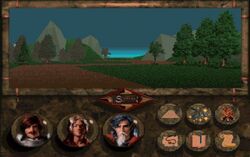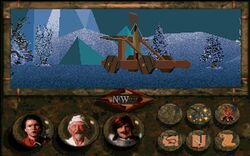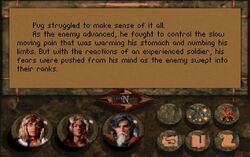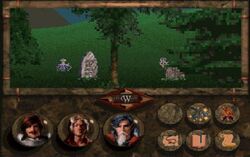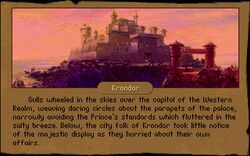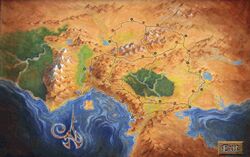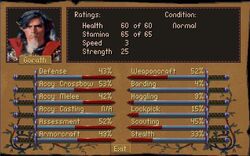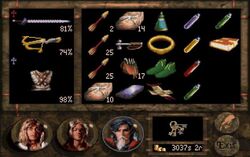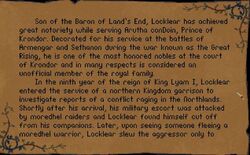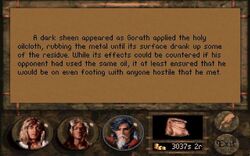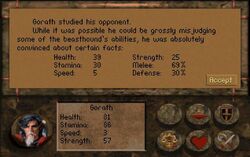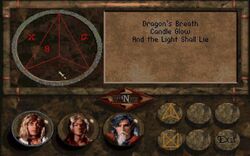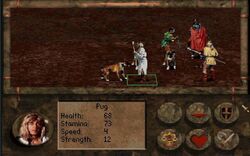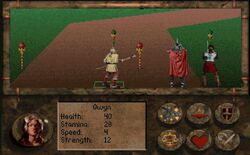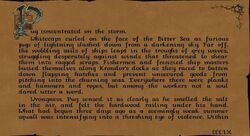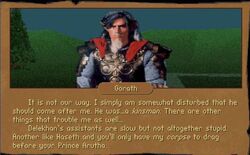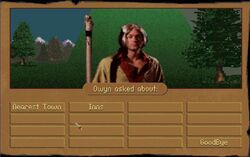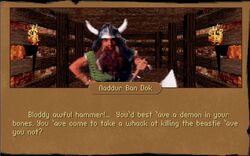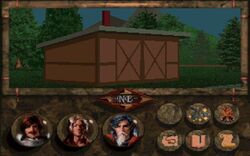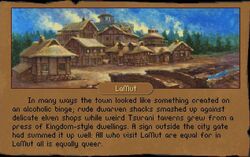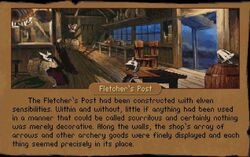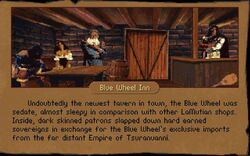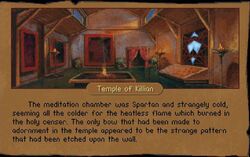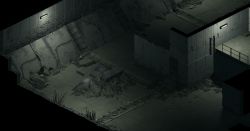Forgotten Gems: Roxoring Betrayal at Krondor
Forgotten Gems: Roxoring Betrayal at Krondor
Codex Review - posted by DarkUnderlord on Mon 11 August 2008, 06:20:24
Tags: Betrayal at Krondor; Dynamix; Sierra EntertainmentAs part of our Forgotten Gems series, Darth Roxor takes a look at the old classic Betrayal at Krondor:
Check the rest here.
As I said before, the game is mostly based around exploration. The world really is huge, and the goodies hidden throughout the map are worth the effort. By venturing too far from the road, you might find chests with basic supplies like food rations, torches, whetstones or herbal packs that speed up the healing rate while resting, or maybe powerful potions that drastically boost your statistics, or simply a new sword or a set of armour if you are not satisfied with your current one. Normal chests can be either harmless, or locked, or trapped, or both. Many traps are lethal, and they can be ‘sensed’ only through a spell, so if you stumble upon such, but you are not quite confident about your lockpicking skill, it’s just better to let it be. Apart from these ‘normal’ chests, there are also Moredhel chests which have a wordlock upon them. When using such a chest, you are presented a riddle, and a few slides with letters. To open the chest, you must make the slides show the password (some of the riddles are really hard, believe me).
Check the rest here.
Written by Darth Roxor
OVERVIEW
Betrayal at Krondor is a vintage RPG developed by Dynamix, and published by Sierra Entertainment in 1993. Taking aside its rather old age and horribly outdated graphics it's still regarded as one of the best the genre has to offer by those who played it. The game is mostly centered around exploration, combat, the plot, and the absolutely fantastic writing, at which many nowadays RPG developers should look, and at least try to implement something similarly great into their games.
So let us begin, shall we?
THE WORLD
Betrayal at Krondor is set in the world of Midkemia, based on the "Riftwar" series by Raymond Feist. It features a large variety of cultures and races. Humans are divided into Keshians, Quegians, Tsurani, and the Kingdom folk. Among the many branches of the elven race, the only featured ones are the Eledhel (the elves of light living in the forest nation of Elvandar in the west), Moredhel (dark elves living in the frozen Northlands, but they aren't of dark skin, Moredhel are just Eledhel who turned away from the path of light). Rarely, a dwarf can also be found in a tavern or in a mine. The game will take the player through dense forests, various villages and cities, mines, sewers, secret underground passages, a wasteland, the snowy Northlands, and of course, regular roads of the Kingdom of the Isles.
The Kingdom, in which the game takes place, is fresh from a war with the great Moredhel warlord Murmandamus, yet a new sinister plot is about to be uncovered, and again, it seems the danger comes from the Moredhel. Starting with a simple mission to escort an informant, then trying to figure out a criminal case, next an all out war, and in the end, something even more nefarious is uncovered to be at work.
THE GAMEPLAY
As I said before, the game is mostly based around exploration. The world really is huge, and the goodies hidden throughout the map are worth the effort. By venturing too far from the road, you might find chests with basic supplies like food rations, torches, whetstones or herbal packs that speed up the healing rate while resting, or maybe powerful potions that drastically boost your statistics, or simply a new sword or a set of armour if you are not satisfied with your current one. Normal chests can be either harmless, or locked, or trapped, or both. Many traps are lethal, and they can be 'sensed' only through a spell, so if you stumble upon one but are not quite confident about your lockpicking skill, it's just better to let it be. Apart from these 'normal' chests, there are also Moredhel chests which have a wordlock upon them. When trying to open such a chest, you are presented with a riddle, and a few blocks with letters. To open the chest, you must arrange the blocks so that they show the password (some of the riddles are really hard, believe me
Apart from chests, alternative routes may also yield side quests, hidden caches with supplies, dungeons, graveyards, villages or just a way to get around a fight you can't win. Watch out though, the Kingdom is a dangerous region, and often you will find yourself ambushed or walk straight into a trap, both on regular roads and while exploring!
When not in combat, you see the world from the first person perspective, you can walk, rest or cast spells (some of them also depend on where or when you are - "Candle glow" gives light, but only underground, while "Stardusk" gives light but only at night). The camera shifts to a different view after combat is initiated, when you enter large cities and buildings such as shops and taverns (however, the people of the Kingdom have 'day cycles' and these buildings will be open only after noon, because between dawn and noon, peasants need to stay in the fields, and your favourite tavern might just be locked) there's an artwork representing the inside of the building or the overview of the city, and you can choose where to go or whom to talk to by clicking on the place/person. When visiting someone's house, you will get a text describing how your party enters the house, what happens inside etc. In taverns, you can get a room and rest (resting in taverns is more effective than in the wilderness), buy rations or just talk to the patrons. In shops you can buy/sell various things depending on what the shop is selling (these are jewelers, general stores, armorers, magical supplies etc) or repair your gear if it's an armorer's shop.
The storyline is linear, there are no choices for you to make, but the game offers a very neatly made illusion of freedom, mainly thanks to the free-roaming and exploration – the goal is always the same, but often there are various paths to it. The plot is also a giantpolitical intrigue, with many twists that make it particularly enjoyable. Side quests will often give you a better insight on what is going on in the world, and it's amazing how almost everything is connected to the main plot in some way. It's also a good idea to get a pencil and a sheet of paper while playing, and note everything you find, because there is no journal, and sometimes you might have a lot of things to do and just forget what had to be done somewhere.
Unfortunately though, some chapters are very low on side quests, however I think it's done on purpose to simulate that 'you have a lot of very important things to do and time is running out, no time for pointless running around, lad'.
THE CHARACTERS AND INVENTORY
In Betrayal at Krondor, you don't create your own party, all characters are forced upon you. During the game, you will control either two or three party members, depending on the chapter, each of them with different personalities. There is a total of six characters available throughout the game, three fighters and three spellcasters. Fans of Feist's novels will probably recognize such characters as Locklear or Jimmy the Hand.
The character sheet is a portrait of the character, his condition, statistics and a list of how proficient he is in various skills. By clicking on the knob of the sword next to a skill you can make the character focus on this particular skill, and make it advance faster than the others. Statistics are: Health (when this drops to 0, your character is near-death), Stamina (this goes down before health when you are hurt or cast spells), Strength (determines how much damage your character does in combat) and Speed (how many tiles your character can cross during combat). Some skills are really unique, like barding and assessment – barding determines how good your character is with a lute and how much gold you will get when attempting to "bard" in taverns, while assessment determines how much information a character will get by studying his enemy in combat. There are also skills such as defence, accuracy for melee, crossbow and casting, haggling, stealth which can help you get past combat undetected or issue surprise attacks, scouting which will warn you that there may be an ambush somewhere nearby, lockpicking which shows how good the character is with opening locks and disarming traps, and weapon/armorcraft, which increases the quality of repairs you can perform on your weapons and armor. Skills are raised by using them or finding people willing to train you. By clicking with the RMB on the character's portrait, you will be presented with his biography. The 'condition' status shows under what effects the character currently is, such as poison, near-death status, sickness, plague or healing. To get rid of negative effects, you either need to rest long enough for them to wear off (which can be really long with such effects as near-death, though Healing powder speeds up the healing rate a lot), drink enough restoratives, use an anti-venom in case of poisoning or visit a temple and pay a large sum of gold to get rid of the effects instantly. Take care though, resting while poisoned or plagued is certain death.
The inventory is limited by slots, for a total of 20 per character. Weapons (except staves) take two slots, armour takes four slots, staves take four slots, everything else takes one, and most of the regular items can be stacked (rations, potions, ropes, etc). Rations are needed all the time to keep your party from starving. Some items have utility uses, such as the rope, which is needed to get through pits in dungeons, shovels to dig up graves, which sometimes hold items (or wraiths), whetstones, bowstrings, armorer's hammers to repair weapons, crossbows, armour. Some items can only be used during combat - those are mainly magic artifacts which can support your party or deal damage to the enemy. Other items such as various potions, oils that give additional temporary properties to armour/weapons can be used both during and before combat. It's also worth mentioning, that whatever you do, you don't just get a simple "unable to do this" or "you've successfully done that" message, everything is followed by a long text describing what your character is doing. For example, when you try to do something totally nonsensical, a text is presented to you, how your character thinks he needs to focus on the task at hand or he'll be dipping his sword in jam and putting poison in his sandwiches next time.
THE COMBAT
Combat in Betrayal at Krondor is turn-based, with a semi-isometric view of the battlefield. Your party starts in the lowest part of the screen, the enemy party in the highest. During your turn, you can move, access the inventory and use all the items you want, unless they take a whole turn to use (mainly magic artifacts), attempt to run away, assess the enemy to find out his stats, rest one turn and regenerate a slight amount of health/stamina, cast a spell, attack in melee, attack with the crossbow, boost your defence ability with the 'defend' function or click the 'auto-combat' function and let the computer fight. Characters can't use ranged weapons and cast spells if there is an enemy right next to them. When attacking in melee, you can either thrust or swing – thrust is more accurate but does less damage, while swing does more damage, but is less accurate and takes stamina to use. Spellcasting draws power directly from your caster's health and stamina, there's no mana, so one has to be careful not to accidentally kill your mage by performing a powerful spell. When characters cast spells/take damage their stamina lowers first, and after it reaches 0, the next spells cast or wounds received will decrease health – while the less health your character has, the bigger penalties he receives to his skills
Characters who have lower than 40 health actually start to get useless in combat, unless they heal themselves.
You can influence the battle a lot before the actual combat even starts. When in the 'world view' you see a group of foes somewhere on the road, you can click on one of them and the party will agree to issue a surprise attack. If your stealth is high enough, and the surprise succeeds you will get the upper hand at the start, and your characters will get to act before the enemy, which means a lot if the enemy has spellcasters.
The only problem I have with the combat is that some spells are ridiculously overpowered. For example, skin of the dragon makes your character absolutely invincible for a variable period of time, spells such as grief of a 1000 nights or fetters of rime will freeze an opponent for a variable period of time, and rarely do you see enemies that are immune to the effect of these spells (those are mainly undead such as shades or rusalki). However, that works both ways – fortunately no enemy group has skin of the dragon, but they often carry the freezing spells, and the mechanic is such, that if all your characters are frozen – you lose instantly.
Apart from combat encounters, you will also come across various traps. These are comprised of 4 elements: 'skull traps', 'cannons', solid pylons and hollow pylons. Skull traps are two vertical poles with skulls on top – walking between the two poles will activate the trap and do massive damage to the character. They can be disabled either by a spell called 'black nimbus' or by making the cannon shoot one of the poles. The cannons are activated if anything comes into their line of sight, after that they shoot a fireball that deals lots of damage. Solid pylons can be used to effectively shutdown cannons by putting them directly in front of said cannon. Hollow pylons are used as 'bait' for the cannons to shoot the skull traps, you have to put the pylon in front of the cannon, and it will shoot through it.
THE WRITING AND DIALOGUE
Even though the writing in the game wasn't done by Raymond Feist, the game actually feels like a book, and it's been designed to look like one too. All messages are on a background that looks like a piece of paper, chapter endings and beginnings are numbered as pages and they begin with an artistic first letter.
As I mentioned at the beginning, the writing is simply excellent – there is almost an absolute lack of one-line texts, everything to read is long, and written in a very good language with lively descriptions, interesting conversations etc.
During conversations, you are presented with a few simple queries to choose from, and the character will 'do the rest'. It's important to pay attention to all the dialogues, since the NPCs will often give you tips, side-quests and important information, and sometimes you might just accidentally overlook it, and that's a very bad thing to do, given the lack of a journal to remember and note things for you.
THE SOUNDS AND GRAPHICS
There's not much to talk about concerning the sounds, there aren't even too many of them. Out of combat, the only sounds you will hear are some birds singing, simple 'gulps' when using potions, 'bangs' when repairing armor, 'swishes' when repairing swords or using healing herbs. In combat there's a 'bang' sound when things get hit and a bit wider array of sounds for various spells, but still nothing too impressive.
However, what there is definitely much to talk about, is the music. From ominous in some dungeons, to epic during combat and pleasant during "barding". I find the theme track in the main menu simply astonishing, and when I was playing it recently, for the first time in a very long time, a tear appeared in my eye, when I heard the MIDI beauty, so long forgotten from the time of my youth.
As I mentioned previously, 'outdoor' graphics are rather outdated, but given the fact that the game is also really old, and that its main factors of greatness lie elsewhere it's possible to just entirely ignore the visuals. However, there is a lot of artwork to be found in various towns, shops, taverns and other specific locations, and these are done very well.
THE CONCLUSION
Despite its old age, and the fact that it was actually criminally overlooked, most of the people who played Krondor still find it to be a really great addition to any RPG fan's collection, and I consider myself to be one of these people. If you didn't play this game, you are missing out on a very pleasant experience, and it's not even a problem to get it, since it's been given Abandonware status by Sierra.
OVERVIEW
Betrayal at Krondor is a vintage RPG developed by Dynamix, and published by Sierra Entertainment in 1993. Taking aside its rather old age and horribly outdated graphics it's still regarded as one of the best the genre has to offer by those who played it. The game is mostly centered around exploration, combat, the plot, and the absolutely fantastic writing, at which many nowadays RPG developers should look, and at least try to implement something similarly great into their games.
So let us begin, shall we?
THE WORLD
Betrayal at Krondor is set in the world of Midkemia, based on the "Riftwar" series by Raymond Feist. It features a large variety of cultures and races. Humans are divided into Keshians, Quegians, Tsurani, and the Kingdom folk. Among the many branches of the elven race, the only featured ones are the Eledhel (the elves of light living in the forest nation of Elvandar in the west), Moredhel (dark elves living in the frozen Northlands, but they aren't of dark skin, Moredhel are just Eledhel who turned away from the path of light). Rarely, a dwarf can also be found in a tavern or in a mine. The game will take the player through dense forests, various villages and cities, mines, sewers, secret underground passages, a wasteland, the snowy Northlands, and of course, regular roads of the Kingdom of the Isles.
The Kingdom, in which the game takes place, is fresh from a war with the great Moredhel warlord Murmandamus, yet a new sinister plot is about to be uncovered, and again, it seems the danger comes from the Moredhel. Starting with a simple mission to escort an informant, then trying to figure out a criminal case, next an all out war, and in the end, something even more nefarious is uncovered to be at work.
THE GAMEPLAY
As I said before, the game is mostly based around exploration. The world really is huge, and the goodies hidden throughout the map are worth the effort. By venturing too far from the road, you might find chests with basic supplies like food rations, torches, whetstones or herbal packs that speed up the healing rate while resting, or maybe powerful potions that drastically boost your statistics, or simply a new sword or a set of armour if you are not satisfied with your current one. Normal chests can be either harmless, or locked, or trapped, or both. Many traps are lethal, and they can be 'sensed' only through a spell, so if you stumble upon one but are not quite confident about your lockpicking skill, it's just better to let it be. Apart from these 'normal' chests, there are also Moredhel chests which have a wordlock upon them. When trying to open such a chest, you are presented with a riddle, and a few blocks with letters. To open the chest, you must arrange the blocks so that they show the password (some of the riddles are really hard, believe me
Apart from chests, alternative routes may also yield side quests, hidden caches with supplies, dungeons, graveyards, villages or just a way to get around a fight you can't win. Watch out though, the Kingdom is a dangerous region, and often you will find yourself ambushed or walk straight into a trap, both on regular roads and while exploring!
When not in combat, you see the world from the first person perspective, you can walk, rest or cast spells (some of them also depend on where or when you are - "Candle glow" gives light, but only underground, while "Stardusk" gives light but only at night). The camera shifts to a different view after combat is initiated, when you enter large cities and buildings such as shops and taverns (however, the people of the Kingdom have 'day cycles' and these buildings will be open only after noon, because between dawn and noon, peasants need to stay in the fields, and your favourite tavern might just be locked) there's an artwork representing the inside of the building or the overview of the city, and you can choose where to go or whom to talk to by clicking on the place/person. When visiting someone's house, you will get a text describing how your party enters the house, what happens inside etc. In taverns, you can get a room and rest (resting in taverns is more effective than in the wilderness), buy rations or just talk to the patrons. In shops you can buy/sell various things depending on what the shop is selling (these are jewelers, general stores, armorers, magical supplies etc) or repair your gear if it's an armorer's shop.
The storyline is linear, there are no choices for you to make, but the game offers a very neatly made illusion of freedom, mainly thanks to the free-roaming and exploration – the goal is always the same, but often there are various paths to it. The plot is also a giantpolitical intrigue, with many twists that make it particularly enjoyable. Side quests will often give you a better insight on what is going on in the world, and it's amazing how almost everything is connected to the main plot in some way. It's also a good idea to get a pencil and a sheet of paper while playing, and note everything you find, because there is no journal, and sometimes you might have a lot of things to do and just forget what had to be done somewhere.
Unfortunately though, some chapters are very low on side quests, however I think it's done on purpose to simulate that 'you have a lot of very important things to do and time is running out, no time for pointless running around, lad'.
THE CHARACTERS AND INVENTORY
In Betrayal at Krondor, you don't create your own party, all characters are forced upon you. During the game, you will control either two or three party members, depending on the chapter, each of them with different personalities. There is a total of six characters available throughout the game, three fighters and three spellcasters. Fans of Feist's novels will probably recognize such characters as Locklear or Jimmy the Hand.
The character sheet is a portrait of the character, his condition, statistics and a list of how proficient he is in various skills. By clicking on the knob of the sword next to a skill you can make the character focus on this particular skill, and make it advance faster than the others. Statistics are: Health (when this drops to 0, your character is near-death), Stamina (this goes down before health when you are hurt or cast spells), Strength (determines how much damage your character does in combat) and Speed (how many tiles your character can cross during combat). Some skills are really unique, like barding and assessment – barding determines how good your character is with a lute and how much gold you will get when attempting to "bard" in taverns, while assessment determines how much information a character will get by studying his enemy in combat. There are also skills such as defence, accuracy for melee, crossbow and casting, haggling, stealth which can help you get past combat undetected or issue surprise attacks, scouting which will warn you that there may be an ambush somewhere nearby, lockpicking which shows how good the character is with opening locks and disarming traps, and weapon/armorcraft, which increases the quality of repairs you can perform on your weapons and armor. Skills are raised by using them or finding people willing to train you. By clicking with the RMB on the character's portrait, you will be presented with his biography. The 'condition' status shows under what effects the character currently is, such as poison, near-death status, sickness, plague or healing. To get rid of negative effects, you either need to rest long enough for them to wear off (which can be really long with such effects as near-death, though Healing powder speeds up the healing rate a lot), drink enough restoratives, use an anti-venom in case of poisoning or visit a temple and pay a large sum of gold to get rid of the effects instantly. Take care though, resting while poisoned or plagued is certain death.
The inventory is limited by slots, for a total of 20 per character. Weapons (except staves) take two slots, armour takes four slots, staves take four slots, everything else takes one, and most of the regular items can be stacked (rations, potions, ropes, etc). Rations are needed all the time to keep your party from starving. Some items have utility uses, such as the rope, which is needed to get through pits in dungeons, shovels to dig up graves, which sometimes hold items (or wraiths), whetstones, bowstrings, armorer's hammers to repair weapons, crossbows, armour. Some items can only be used during combat - those are mainly magic artifacts which can support your party or deal damage to the enemy. Other items such as various potions, oils that give additional temporary properties to armour/weapons can be used both during and before combat. It's also worth mentioning, that whatever you do, you don't just get a simple "unable to do this" or "you've successfully done that" message, everything is followed by a long text describing what your character is doing. For example, when you try to do something totally nonsensical, a text is presented to you, how your character thinks he needs to focus on the task at hand or he'll be dipping his sword in jam and putting poison in his sandwiches next time.
THE COMBAT
Combat in Betrayal at Krondor is turn-based, with a semi-isometric view of the battlefield. Your party starts in the lowest part of the screen, the enemy party in the highest. During your turn, you can move, access the inventory and use all the items you want, unless they take a whole turn to use (mainly magic artifacts), attempt to run away, assess the enemy to find out his stats, rest one turn and regenerate a slight amount of health/stamina, cast a spell, attack in melee, attack with the crossbow, boost your defence ability with the 'defend' function or click the 'auto-combat' function and let the computer fight. Characters can't use ranged weapons and cast spells if there is an enemy right next to them. When attacking in melee, you can either thrust or swing – thrust is more accurate but does less damage, while swing does more damage, but is less accurate and takes stamina to use. Spellcasting draws power directly from your caster's health and stamina, there's no mana, so one has to be careful not to accidentally kill your mage by performing a powerful spell. When characters cast spells/take damage their stamina lowers first, and after it reaches 0, the next spells cast or wounds received will decrease health – while the less health your character has, the bigger penalties he receives to his skills
Characters who have lower than 40 health actually start to get useless in combat, unless they heal themselves.
You can influence the battle a lot before the actual combat even starts. When in the 'world view' you see a group of foes somewhere on the road, you can click on one of them and the party will agree to issue a surprise attack. If your stealth is high enough, and the surprise succeeds you will get the upper hand at the start, and your characters will get to act before the enemy, which means a lot if the enemy has spellcasters.
The only problem I have with the combat is that some spells are ridiculously overpowered. For example, skin of the dragon makes your character absolutely invincible for a variable period of time, spells such as grief of a 1000 nights or fetters of rime will freeze an opponent for a variable period of time, and rarely do you see enemies that are immune to the effect of these spells (those are mainly undead such as shades or rusalki). However, that works both ways – fortunately no enemy group has skin of the dragon, but they often carry the freezing spells, and the mechanic is such, that if all your characters are frozen – you lose instantly.
Apart from combat encounters, you will also come across various traps. These are comprised of 4 elements: 'skull traps', 'cannons', solid pylons and hollow pylons. Skull traps are two vertical poles with skulls on top – walking between the two poles will activate the trap and do massive damage to the character. They can be disabled either by a spell called 'black nimbus' or by making the cannon shoot one of the poles. The cannons are activated if anything comes into their line of sight, after that they shoot a fireball that deals lots of damage. Solid pylons can be used to effectively shutdown cannons by putting them directly in front of said cannon. Hollow pylons are used as 'bait' for the cannons to shoot the skull traps, you have to put the pylon in front of the cannon, and it will shoot through it.
THE WRITING AND DIALOGUE
Even though the writing in the game wasn't done by Raymond Feist, the game actually feels like a book, and it's been designed to look like one too. All messages are on a background that looks like a piece of paper, chapter endings and beginnings are numbered as pages and they begin with an artistic first letter.
As I mentioned at the beginning, the writing is simply excellent – there is almost an absolute lack of one-line texts, everything to read is long, and written in a very good language with lively descriptions, interesting conversations etc.
During conversations, you are presented with a few simple queries to choose from, and the character will 'do the rest'. It's important to pay attention to all the dialogues, since the NPCs will often give you tips, side-quests and important information, and sometimes you might just accidentally overlook it, and that's a very bad thing to do, given the lack of a journal to remember and note things for you.
THE SOUNDS AND GRAPHICS
There's not much to talk about concerning the sounds, there aren't even too many of them. Out of combat, the only sounds you will hear are some birds singing, simple 'gulps' when using potions, 'bangs' when repairing armor, 'swishes' when repairing swords or using healing herbs. In combat there's a 'bang' sound when things get hit and a bit wider array of sounds for various spells, but still nothing too impressive.
However, what there is definitely much to talk about, is the music. From ominous in some dungeons, to epic during combat and pleasant during "barding". I find the theme track in the main menu simply astonishing, and when I was playing it recently, for the first time in a very long time, a tear appeared in my eye, when I heard the MIDI beauty, so long forgotten from the time of my youth.
As I mentioned previously, 'outdoor' graphics are rather outdated, but given the fact that the game is also really old, and that its main factors of greatness lie elsewhere it's possible to just entirely ignore the visuals. However, there is a lot of artwork to be found in various towns, shops, taverns and other specific locations, and these are done very well.
THE CONCLUSION
Despite its old age, and the fact that it was actually criminally overlooked, most of the people who played Krondor still find it to be a really great addition to any RPG fan's collection, and I consider myself to be one of these people. If you didn't play this game, you are missing out on a very pleasant experience, and it's not even a problem to get it, since it's been given Abandonware status by Sierra.
There are 17 comments on Forgotten Gems: Roxoring Betrayal at Krondor





